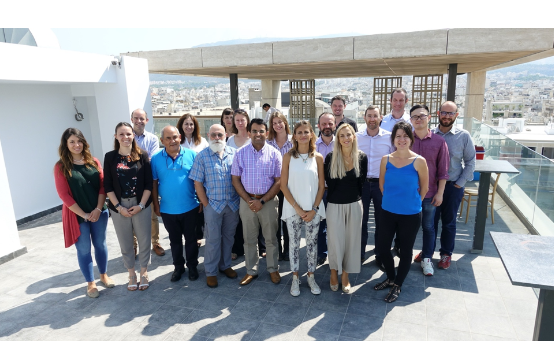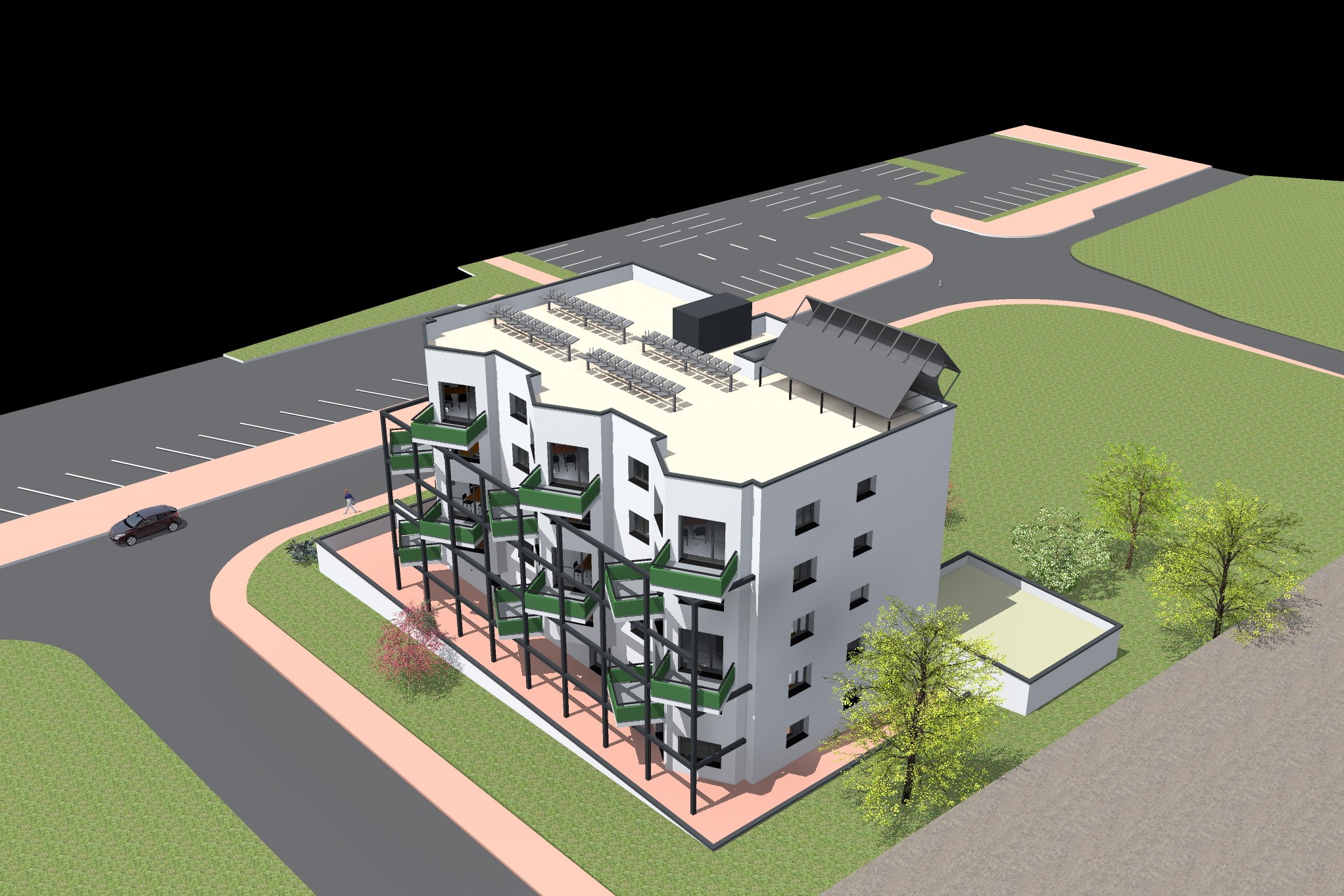ZERO-PLUS: Meeting Europe’s demand for energy efficient settlements in 2020
27 February 2020, Diane Amancic, Category: All insights, Latest projects, News, Tags: energy efficient buildings, EU, europe, Horizon 2020, market assessment, strategy development, sustainable buildings, ZERO-PLUS

Achieving near Zero and Positive Energy Settlements in Europe using Advanced Energy Technology. The photo above was taken with the ZERO-PLUS team at Grenoble, October 2018. Read our brochure on the ZERO-PLUS project, published in March 2020.
Since 2016, E Co. has been involved in ZERO-PLUS – an EU Horizon 2020-funded project. The project aims to develop and implement a collaborative management approach to the design and construction of near-zero energy efficient settlements. Senior consultant Morna Isaac and Consultant Diane Amancic have been working on the final stages of the project…
Where is the project now, as of February 2020?
After four years, E Co.’s involvement in the project has finally come to an end.
Following our submission of the Sample Business Plan and approval from European Commission, our project partners will now be disseminating the project results, finalising the tools, and seeking investors to transform the project concept into a workable business model.
ZERO-PLUS has developed a method and tools for the construction of new residential Net Zero Energy Settlements (NZES). Focusing on settlements as opposed to single buildings, the project aims to bring together technology suppliers, energy efficiency and renewable energy experts and developers who work together from the earliest stages of project conception to optimise the NZES design.
The implementation of ZERO-PLUS aims to achieve a comprehensive, cost-effective system for the design, construction and monitoring of Net Zero Energy Settlements – a system which has been successfully piloted in four projects across Europe (in France, the UK, Italy and Cyprus).
In a nutshell, the buildings will achieve, at the very minimum:
- 16% cost reduction compared to the reference case
- Net regulated energy consumption of < 20 kWh/m2/year
- Energy production by RES of > 50 kWh/m2/year
And how have we contributed?

Zero Plus meeting in Athens, 2019. E Co. Senior consultant Morna Isaac and consultant Diane Amancic in the second row, middle.
Since 2016, our team at E Co. have undertaken:
- A market analysis of trends in the construction market for highly energy performing buildings. We focused in particular on near zero and positive energy settlements. Our report provided a literature review, illustrative case studies and personal interviews with project participants.
- An analysis of the business case for the application of the technologies and processes developed in the project – we compared the costs, benefits, risks & deliverability associated with several options to develop a viable business model in order to identify the type of business that would best fit the nature of the project.
- An analysis of the market potential within the EU28 for ‘Nearly Zero-Energy’ performance buildings, constructed using the concepts developed in the project. This particular report analysed the market potential within the EU28 for Nearly Zero-Energy Buildings (NZEBs) and explores traditional contracting processes.
- A sample business plan which lays out potential directions for the commercial exploitation of the tools and methodology developed during the ZERO-PLUS project.
We’ve drawn on our experience working on: the Green Cities Action Plans (GCAPs) in multiple cities across Europe, our market assessment for energy efficient buildings in Montenegro and the regulation of energy efficient buildings in Georgia. We’ve also been involved, within the sector, in the development of concept notes, funding proposals and CEO endorsement documents for the GCF and GEF.
Buildings and settlements are nowadays increasingly expected to meet higher and potentially more complex levels of performance. They should be sustainable, use zero-net energy, be healthy and comfortable and both grid-friendly yet economical to build and maintain. Buildings are central to the EU’s energy efficiency policy and contribute to the continent’s shift towards sustainable development.
Our Market assessment and Strategy development
Three approaches were used to project the continent-wide market potential:
- To assess the market volume and value, the analysis used the Top down approach which looks at the relationship between GDP and the size of the residential construction market.
- We also used the demand-side approach to assess the expected demand for new residential construction based on demographic trends.
- The final approach was the supply side approach, which looks at the trends in building permits issued in selected countries, along with the evolution of construction costs.
The combined analysis of the trends in residential building construction in Europe revealed the significant weight and scale of the market. With a combined population of about 500 million people, the EU represents the world’s largest single economic market in terms of combined GDP, with significant variance in per-capita GDP across the 27 member states. The total European building stock is close to 24 billion m2 and almost 75% are residential buildings, with an average floor space close to 87 m2 per dwelling.
Worth at least EUR 1.2 trillion of yearly turnover (in 2011), the European construction sector, including its extended value chain, is the largest single European activity (9.6% of GDP) and the biggest industrial employer (14.6 million direct operatives, 30.7% of industrial employment, 43.8 million indirect workers).
The expected increase in population until 2040 will require the construction of 4 million new homes across the EU as a whole by 2020, about 6 million more between 2021 and 2030, and another 4.6 million between 2031 and 2040. In total, more than 14 million new homes will be needed by 2040 in the EU as a whole. In line with the demand-side approach, the growth of the total dwelling stock ought to continue to increase by 2.8% on average in the EU as a whole.
Vision and impact of ZERO-PLUS

Why was the ZERO-PLUS project so unique to the E Co. team? There were a number of reasons:
For starters, the collaboration opportunities with universities, research institutions, housing associations, and engineering firms. This collaboration produced a truly innovative concept for the design of NZEBs which incorporates the concerns and interests of a broad range of different stakeholders.
Secondly, as demand for highly energy efficient buildings increases, systemic barriers hinder progress towards a more sustainable building stock. These barriers include: the uncoordinated construction supply chain and the lack of clear guidelines on how to build cost-effective net zero-energy dwellings. The ZERO-PLUS concept streamlines the design and construction process of highly energy efficient residential settlements by using an integrated, iterative and collaborative approach to design and construction management.
Finally, the expected impacts of employing the ZERO-PLUS approach are: an improved energy and environmental performance at the building and settlement level, including improved comfort and a lower financial burden on involved parties. The ZERO-PLUS approach also aims to help the private sector to comply with national and EU level legislation, as well as increasing profitability by reducing construction and maintenance costs compared to conventional energy efficient buildings.
Learn more about ZERO-PLUS!
To learn more about ZERO-PLUS, Horizon 2020 and the implementation, head to the ZERO-PLUS website. Or drop us a line at amy@ecoltdgroup.com and Diane and Morna will get back to you.


Join the conversation by posting a comment below. You can either use your social account, by clicking on the corresponding icons or simply fill in the form below. All comments are moderated.